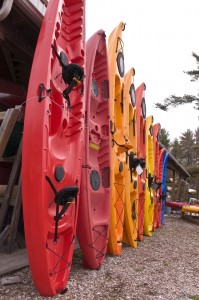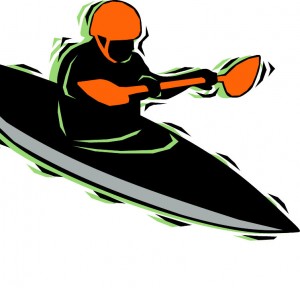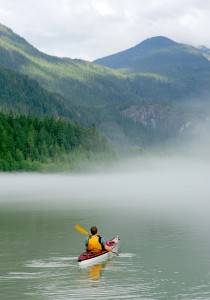How to Properly Store Your Kayak or Canoe
Most paddlers have experienced the unfortunate event of climbing out of the water and noticing some of their gear is broken or ripped. Repairing and buying new kayak or canoe gear can be very expensive and that is one of  the main reasons why it is so important to keep your equipment stored properly while they aren’t being used. Whether it’s getting too cold to paddle or you’re just putting away your kayak for the week, it is important that you take every step to ensure that your equipment is properly stored. Getting as much life as possible out the paddling jackets, gloves, and whatever else you paddle with is essential to getting your money’s worth. Here are some of the ways to properly store your canoe or kayak.
the main reasons why it is so important to keep your equipment stored properly while they aren’t being used. Whether it’s getting too cold to paddle or you’re just putting away your kayak for the week, it is important that you take every step to ensure that your equipment is properly stored. Getting as much life as possible out the paddling jackets, gloves, and whatever else you paddle with is essential to getting your money’s worth. Here are some of the ways to properly store your canoe or kayak.
One of the most obvious and often times forgotten step is to make sure that all of your equipment is dry. After a long day on the water, you climb out of your canoe or kayak, throw the gear in the back of your truck or on top of your car and make the drive home. By the time you’re home its dark out and you’re too tired to unpack all of your gear and you say to yourself that you’ll do it the next day when it’s bright out. However, the week goes on and the gear is forgotten until the next time you take it out. The damage has already been done and there is no way to reverse it except for getting repairs when it gets broken from mistreatment. Spending an extra 10 or 15 minutes after a day on the water to rinse your gear and hang it up will ensure that it’s dry and ready to be stored.
Techniques for better paddle control
Few things can bring as much pleasure and relaxation to an avid outdoorsman or woman than time spent on the water in either a canoe or kayak; this discussion focuses on canoeing. One of the secrets to getting the most out of  these activities is to hone one’s skill sufficiently to minimize effort and maximize time spent enjoying the beauty of the environment. By following some of the techniques discussed below, one can improve one’s paddle control on the water and, in term, derive an ever-increasing level of enjoyment from these pursuits. While it is certainly unnecessary for everyone who wishes to enjoy canoeing or kayaking to become an expert, paddle control will reduce frustration and make your experience more rewarding; furthermore, more advanced individuals should be able to further expand their skills by applying some of these techniques.
these activities is to hone one’s skill sufficiently to minimize effort and maximize time spent enjoying the beauty of the environment. By following some of the techniques discussed below, one can improve one’s paddle control on the water and, in term, derive an ever-increasing level of enjoyment from these pursuits. While it is certainly unnecessary for everyone who wishes to enjoy canoeing or kayaking to become an expert, paddle control will reduce frustration and make your experience more rewarding; furthermore, more advanced individuals should be able to further expand their skills by applying some of these techniques.
There are several ways to improve one’s paddle control, as well as several strokes that will help you to maintain greater control in guiding your vessel along in the water. These technique tips can be broken down into three main groups: hand position, body position, and stroke type. What follows is a brief discussion of each that can form the basis of increased enjoyment and understanding by novice to advanced canoe enthusiasts.
Paddlin in Cold Water
hether canoe or kayak, the number of paddling enthusiasts grows every year. The reasons for paddling are as diverse as the people who take up paddles and venture into streams and oceans. Exercise is the goal of many  paddlers but others enjoy the peace and quiet they find away from more traditional outdoor activities. Photographers and anglers can get to difficult to reach areas and families find paddling an activity that all members can take part in as they enjoy the togetherness that is so rare in today’s busy world. Paddling is fun, relaxing, and exciting but the thrill can turn to danger when paddling in cold water.
paddlers but others enjoy the peace and quiet they find away from more traditional outdoor activities. Photographers and anglers can get to difficult to reach areas and families find paddling an activity that all members can take part in as they enjoy the togetherness that is so rare in today’s busy world. Paddling is fun, relaxing, and exciting but the thrill can turn to danger when paddling in cold water.
You already know the basics of paddling, hopefully from instructors who know what they’re doing. You know how to swim and have practiced self rescue. You have a personal flotation device (PFD), a paddle, and another person with you. But do you know how to prepare for cold water paddling and how to survive if you land in the water?
A guide to inflatable canoes
Picking an inflatable canoe is an exciting proposition. Choosing the right canoe for your needs guarantees many hours of boating pleasure and years of low-maintenance, cost-saving outdoor adventures. 
The advantages of owning an inflatable canoe over an aluminum, Kevlar or plastic canoe are many.
One of the first things the new owner of an inflatable canoe discovers is the ease of transporting it. Inflatable canoes can be folded up, tucked into a carry bag, and tossed into the trunk or back seat and taken anywhere your vehicle can go. Once you arrive, if you’re interested in going even further, you can put the canoe on your shoulder and start walking. Portaging is the age-old adversary of many canoeists and has stopped a lot of adventurers in their tracks. The daunting task of hauling a heavy canoe along with your gear around a rapids often means the end of the trip and starting out for home.
Navigating a Kayak through the Fog
Navigating through the fog in a kayak can be a dangerous task to take on. There are two types of fog, sea fog and radiation fog. Sea fog, also known as advection fog, is a thick fog with strong wind that lasts for days. Radiation fog  is still and burns off throughout the day. Though it isn’t by any means a sure fire way to avoid fog, checking the weather reports before kayaking is a good way to start.
is still and burns off throughout the day. Though it isn’t by any means a sure fire way to avoid fog, checking the weather reports before kayaking is a good way to start.
The risk in fog obviously comes from the drop in visibility, and fog can come on suddenly and intensely. When your visibility is restricted to between 30 to 150 yards, most other objects often look twice as large as they really are, a visual twist which also makes it look like these objects are moving twice as fast as they truly are. On top of this, the stress and the exhaustion of dealing with the fog may cause you to think you are seeing things that are not there. Along with this exhaustion, be aware that no matter how good you are at feeling your way a certain direction, that ability will fade as the time spent in the fog progresses. If you note the fog approaching rather than having it suddenly settle upon you, moving towards the shore is a good idea.
